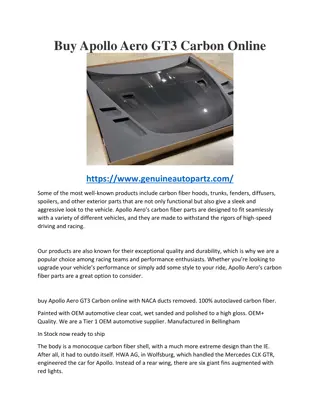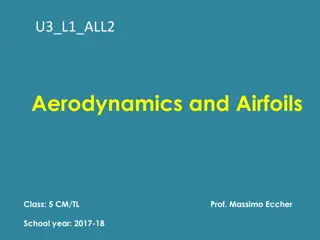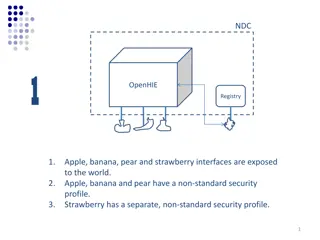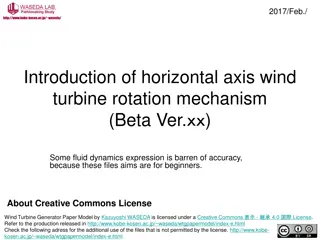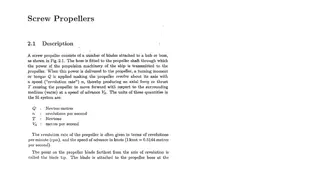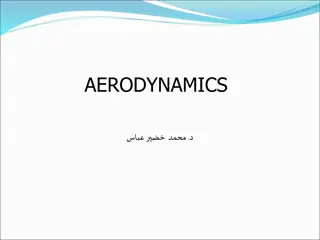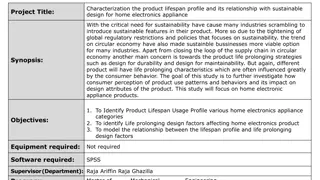NACA Airfoil Profiles and Design Principles
The National Advisory Committee for Aeronautics (NACA), precursor to NASA, revolutionized airfoil design with its systematic approach and NACA airfoil naming convention. Learn about the significance of NACA codes in generating precise airfoil shapes, including examples like the NACA four-digit series. Explore the impact of airfoil thickness on aircraft performance, exemplified by iconic planes like the F-104 Lockheed Starfighter. Delve into the historical context and engineering intricacies of NACA profiles in aviation.
Download Presentation

Please find below an Image/Link to download the presentation.
The content on the website is provided AS IS for your information and personal use only. It may not be sold, licensed, or shared on other websites without obtaining consent from the author.If you encounter any issues during the download, it is possible that the publisher has removed the file from their server.
You are allowed to download the files provided on this website for personal or commercial use, subject to the condition that they are used lawfully. All files are the property of their respective owners.
The content on the website is provided AS IS for your information and personal use only. It may not be sold, licensed, or shared on other websites without obtaining consent from the author.
E N D
Presentation Transcript
U3_L3_ALL1 NACA profiles Class: 5 CM/TL School year: 2017-18 Prof. Massimo Eccher
NACA (National Advisory Committee for Aeronautics) https://en.wikipedia.org/wiki/National_Adv isory_Committee_for_Aeronautics#/media/ File:NACA_seal.jpg NACA, precursor to NASA, was a U.S. agency founded in 1915 to institutionalize aeronautical research. The NACA airfoils are airfoil shapes described using a series of digits. Before NACA series, airfoil design was rather arbitrary. The parameters in the code can be entered into equations to precisely generate the cross-section of the airfoil.
NACA AIRFOIL NAMING CONVENTION Early NACA series, 4- 5- digit series were generated with analytical equations. Later families, including 6-digit series, are more complicated shapes. Example: 4-digit series camber mean line First digit specifies maximum camber in percentage of chord chord Second digit indicates position of maximum camber in tenths of chord Last two digits provide maximum thickness of airfoil in percentage of chord Leading edge radius By the author
EXAMPLE: NACA FOUR-DIGIT SERIES First digit specifies maximum camber in percentage of chord Second digit indicates position of maximum camber in tenths of chord Last two digits provide maximum thickness of airfoil in percentage of chord Adapted from https://commons.wikimedia.org/wiki/File:NACA_2415.svg Example: NACA 2415 Airfoil has maximum thickness of 15% of chord (0.15c) Camber of 2% (0.02c) located 40% back from airfoil leading edge (0.4c)
AIRFOIL THICKNESS: World War I AIRPLANES English Sopwith Camel https://riseofflight.com/forum/topic/26617-fokker-dvii/ Lower maximum CL Thin wing, bracing wires required http://acepilots.com/wwi/sop_camel.html German Fokker Dr-1 https://riseofflight.com/forum/topic/26617-fokker-dvii/ Higher maximum CL Higher rates of climb Improved maneuverability http://www.fiddlersgreen.net/models/aircraft/Fokker-Dr1.html What about their NACA codes?
EXAMPLE: F-104 LOCKHEED STARFIGHTER http://www.fiddlersgreen.net/models/ aircraft/Lockheed-F104.html 1958 used in Vietnam First airplane designed for sustained flight at Mach 2 Very sharp leading edge on wings (razor sharp leading edges, thickness 3.4 %) Designed to minimize wave drag at supersonic speeds Very poor low-speed aerodynamic performance Such wings tend to stall at low angles of attack, CLmaxis only about 1.15 Vstall(full) ~ 198 MPH, Vstall(empty) ~ 152 MPH (Vstallproportional to W1/2)
EXAMPLE: BOEING 727 https://forum.ysfhq.com/viewtopic.php?t=4956 http://www.tailsthroughtime.com/2010/04/ive-always-had-soft-spot-for- boeing-727.html Commercial airplane Designed in 1960 s to operate out of airports with relatively short runways Desire to minimize take-off and landing distances Maximum CL= 3.0 Vstall~ 113 MPH
4 cases Images adapted from: http://www.apollocanard.com/4_airfoil%20design.htm NACA 2415 flying right side up Zero angle of attack Lift in positive vertical direction NACA 2415 upside down Zero angle of attack Lift in negative vertical direction What if we turn it upside down? Positive angle of attack Say =10 Lift in positive vertical direction
CAN AN AIRFOIL PRODUCE LIFT WHEN IT IS FLYING UPSIDE DOWN? Images adapted from: http://www.apollocanard.com/4_airfoil%20design.htm NACA 2415 flying upside down at certain angles of attack will generate positive lift, but less than same airfoil right side up at the same angle of attack Here is a way to understand this: If we take airfoil on left and turn it upside down it is same as airfoil right side up but with a negative angle of attack Therefore, lift coefficient for upside down airfoil at a positive angle of attack is given by data for negative angles of attack The negative cl connotes a downward lift on the ordinary right side up airfoil when pitched to a negative angle of attack In upside down orientation (airfoil on right), lift is directed upwards


